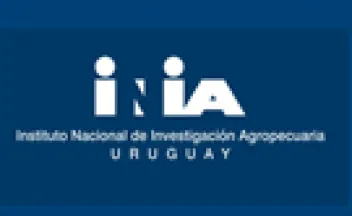Instituto Nacional de Investigación Agropecuaria
Irrigation management strategies to increase water productivity in Oryza sativa (rice) in Uruguay.

Traditional rice irrigation systems in Uruguay are fully irrigated and early continuously flooded irrigation accounts for a high volume of water used. The purpose of this study was to determine irrigation techniques that increase irrigation water productivity (WPi) allowing a reduction in water input without negatively affecting grain yield in Uruguay. Ten experiments were conducted over a six-year period from 2009 to 2015, in three experimental units located among the major rice growing regions.
Atributos do solo e biomassa radicular após quatro anos de semeadura direta de forrageiras de estação fria em campo natural dessecado com herbicidas ? [Soil properties and root system after four years of direct drilling of winter growing forage on a native grassfield dissected with herbicides].

RESUMO:Os campos naturais, desenvolvidos sobre solos arenosos da região norte do Uruguai, são compostos por espécies forrageiras, sobretudo de gramíneas de produção estacional, com baixa produtividade no inverno. O objetivo deste estudo foi avaliar o efeito da dessecação do campo natural no estabelecimento de espécies de estação fria em atributos do solo e biomassa radicular. O estudo, iniciado em 1994, utilizou delineamento experimental de blocos ao acaso com parcelas subsubdivididas, com três repetições.
Effect of Condensed Tannins in Lotus uliginosus cv. E-Tanin and/or Extracts of Quebracho and Chestnut in Carcass and Lamb Meat. [Efecto de taninos condensados de Lotus uliginosus cv. E-Tanin y/o extractos de quebracho-castaño en canal y carne de cordero].

Summary:The effect of condensed tannins (CT) in the pasture (Lotus uliginosus cv. E-Tanin) and/or quebracho and chestnut extracts on lamb carcass and meat quality was evaluated. Two experiments were conducted in consecutive years with 60 crossbreed lambs each year.
Antral follicular count is a tool that may allow the selection of more precocious Bradford heifers at weaning.

Although antral follicle count is a repeatable parameter across life that is positively associated with fertility, its use at weaning as a tool to discard less fertile heifers has not been extensively evaluated.
Using soil-based and physiographic variables to improve stand growth equations in Uruguayan forest plantations.

Information provided by traditional growth models is an essential input in decision making processes for managing planted forests. They are generally fitted using inventory data guaranteeing robustness and simplicity. The introduction of explanatory factors affecting tree development in age-based sigmoidal growth and yield equations attempts not only to improve the quality of predictions, but also to add useful information underpinning forest management decisions.
Structural characterisation of new immunoadjuvant saponins from leaves and the first study of saponins from the bark of Quillaja brasiliensis by liquid chromatography electrospray ionisation ion trap mass spectrometry.
.

Abstract. Introduction:Quillaja brasiliensis (St. A. ?Hil. & Tul) Mart (Quillajaceae) is a species native to South America, which is rich in saponins. Saponins are used in different industries, so there is a constant demand for this type of compound. Based on the wide range of applications for the saponins found in this species, notably as immunoadjuvants, we conducted a comprehensive study of this tree and its saponins. Objective:The purpose of this work is to complete the characterisation of the immunoadjuvant saponin fraction from Q.
Restricted oats grazing and its frequency of allocation affects calves´ performance on native grasslands.

SUMMARY:Nutritional constraints of rearing calves on native grasslands during their first winter is a common problem in Uruguay due to insufficient quality and quantity of forage. Winter supplementation on beef cattle grazing native grasslands using grains or their by-products has been studied before, but little attention has been given to restricting the access of animals to an adjacent enhanced forage basis, such as oats forage.
Mejora de la competitividad de la cadena cárnica bovina en México y Uruguay: Calidad de producto y buenas prácticas de manejo.

A nivel mundial existe una constante demanda de alimentos de origen animal que deben ser producidos bajo criterios de calidad, incluyendo la sanidad animal y la inocuidad alimentaria. Para cumplir con estas exigencias es necesario realizar trabajos de mejora continua en los procesos productivos. La producción de carne de res en México es una de las principales fuentes de generación de valor en el sector agropecuario. En la última década, esta actividad ha crecido a un ritmo promedio de 1.6 % anual, además se observa diversificación de mercados y reducción de importaciones del producto.
Paginación
- Página anterior
- Página 134
- Siguiente página
